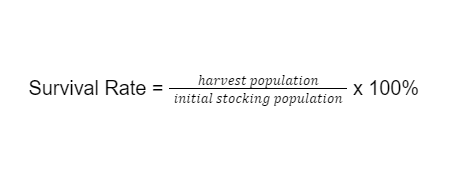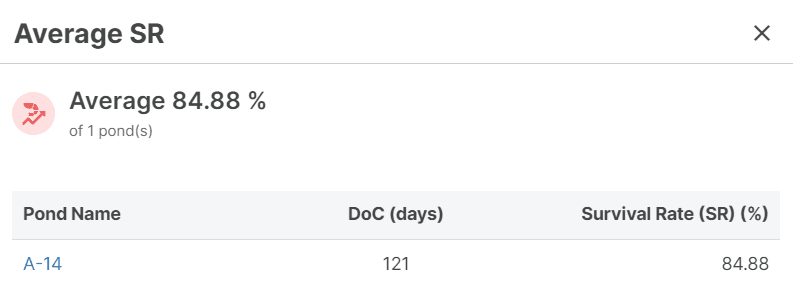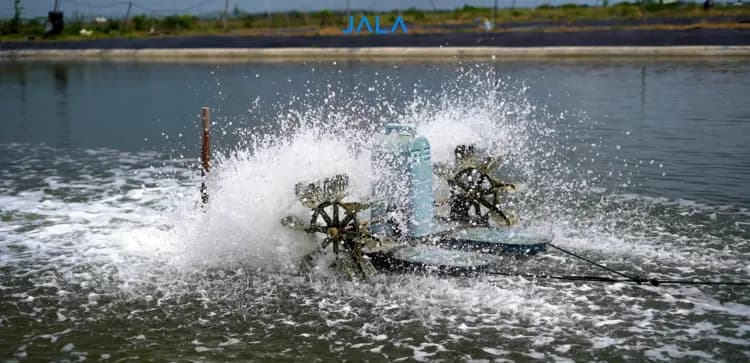
The SR of vannamei shrimp is one of the key parameters that determines cultivation success. To achieve success and desired productivity, you need to pay attention to this aspect.
A low SR or survival rate percentage indicates that the shrimp in the pond have poor resistance. If a shrimp farming cycle has an SR of 40%, it is possible that the cycle is infected by disease and inappropriate handling, resulting in suboptimal cultivation or worse, mass mortality.
Then, what is the ideal SR percentage and what are the factors that affect it? Read further in the discussion below.
What is Survival Rate (SR)?
The SR of vannamei shrimp is the survival rate during one cultivation cycle and is measured in percent. The high or low SR percentage indicates the survival of shrimp in the pond during one cultivation cycle. The SR percentage is obtained by dividing the shrimp population at harvest by the population at initial stocking then multiplying it by 100%.
How to Calculate the SR
Before calculating the SR of vannamei shrimp, identify the shrimp population at harvest and the amount of shrimp fry stocked at the beginning of cultivation. This stocking amount can be determined from stocking density, the number of ponds, and the area of each pond.
Once obtaining those data, you can use this formula to calculate the SR of vannamei shrimp:

For example, Mr. Jali stocked shrimp fry with a density of 100 PL/m² in 2 ponds, each measuring 100 m². During harvest time, there were a total of 16,500 shrimp in his two ponds.
First of all, Mr. Jali calculated the stocking population at the beginning of cultivation using the following way:
Initial stocking population = 100 PL/m² x 2 x 100 m² = 20,000 shrimp
Survival Rate = 16,500 / 20,000 x 100% = 82.5%
Based on the calculations above, the survival rate of Pak Jali’s shrimp was 82.5%.
What is the Average SR of Vaname Shrimp?
According to The Fish Site, the ideal SR percentage is 80-90%. This percentage is the ideal standard for household scale ponds with a stocking density of 100-125 PL/m².
However, based on research by JALA Team, the SR of most shrimp cultivation in Indonesia in 2023 with a stocking density of ≤80 PL/m² and 80-200 PL/m² was at least 50% or more. Meanwhile, most cultivations with stocking density of >200 PL/m² resulted in an SR of >56,17%.
Monitoring SR Using JALA App
The SR of vannamei shrimp is typically calculated at harvest, once the population of harvested shrimp is known. However, you can still monitor SR estimates easily through JALA App, a shrimp farm management app from JALA.
You can find this SR estimate on JALA App dashboard. As soon as your cultivation cycle is finished, you can see the average SR displayed on the same feature. Each pond’s average SR will be displayed along with the cycle duration or Day of Culture (DoC).

To obtain an estimate or average SR, make sure you complete daily feed data and routine sampling. The more complete your data, the more accurate the SR estimate provided by JALA App.
Factors that Affect SR
Cultivation methods have a significant influence on the SR of shrimp. This cultivation aspect, if it is addressed at all, includes water quality, feed, stocking density, and shrimp fry. It does not, however, rule out the possibility that SR is also affected by external factors like the weather.
The following are the factors that affect shrimp SR and their brief explanation:
1. Weather
Shrimp farming is still related to the weather. Weather elements such as temperature, precipitation, and excessive fluctuations may affect shrimp farm conditions and have a domino effect on water quality. In the long term, shrimp are more susceptible to disease due to the disturbed growing medium.
2. Water Quality
Water quality parameters such as pH, salinity, dissolved oxygen, ammonia concentration, and many others have an important role in the survival of shrimp. Parameters that change drastically risk making shrimp more susceptible to disease. Shrimp’s ability to survive can be threatened.
3. Feed Quality and Nutrition
The survival of shrimp also depends on high-quality feed. Contaminated feed will have a negative impact on shrimp health. Likewise, shrimp will not grow well if the nutrition in the feed does not meet their demands.
4. Stocking Density
SR is closely related to the pond environment, including stocking density. An excessively high stocking density will increase the competition level among shrimp to get sufficient dissolved oxygen and feed. If oxygen needs are not met properly, shrimp will have decreasing appetite and their growth rate may slow down.
5. Shrimp Fry Immunity
Shrimp fry have a significant role not only at the beginning of cultivation. Its immunity during cultivation will determine SR. Using high quality fry guaranteed with a Specific Pathogen Free (SPF) certificate will support a high SR percentage.
6. Mortality Caused by Disease
SR can also be affected by shrimp diseases with high mortality rate, such as Acute Hepatopancreatic Necrosis Disease (AHPND) or Early Mortality Syndrome (EMS) and White Spot Disease (WSD). The number of shrimp deaths will affect the shrimp population that survive until harvest.
Conclusion
The SR of vannamei shrimp is the survival rate during one cycle. To calculate the SR, divide the shrimp population at harvest by the population at stocking and multiply the result by 100%.
SR is affected by several factors, namely
- Weather
- Water quality
- Feed quality and nutrition
- Stocking density
- Shrimp fry immunity
- Mortality caused by disease
To find out the estimated SR of your cultivation cycle, you can use JALA App. The SR estimation and average feature in JALA App will make it easier for you to identify the estimates and averages of the SR without the hassle of calculating manually.
Additionally, JALA App is #HeretoHelp you to record and monitor other cultivation parameters as well as understand cultivation conditions more conveniently. What are you waiting for? Register yourself now at app.jala.tech and download the mobile version of JALA App on Google Play Store or App Store.

References





